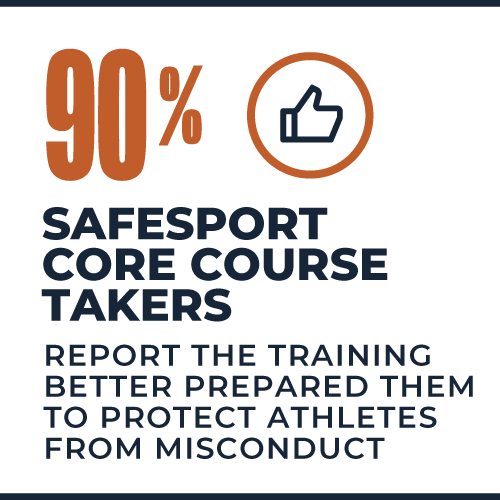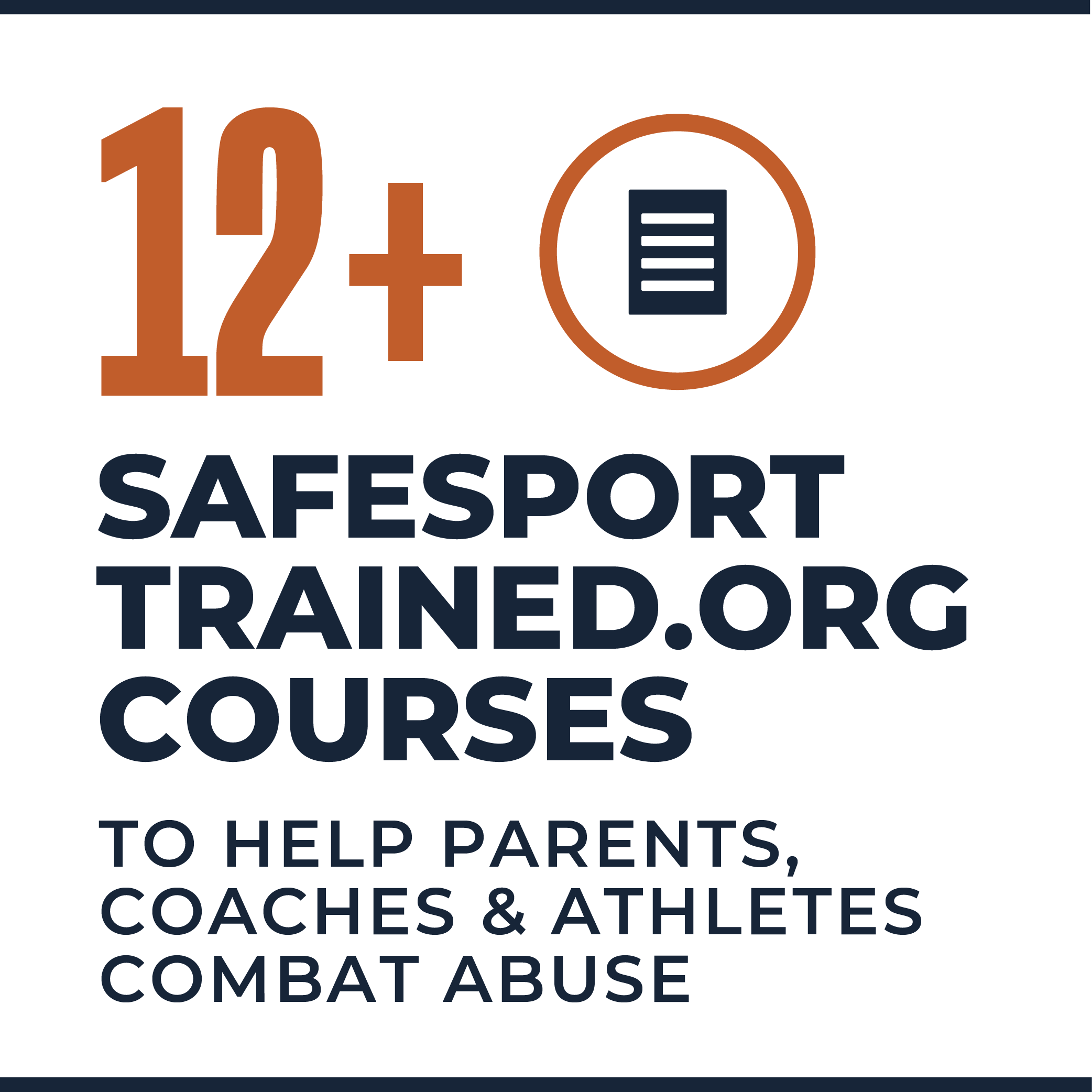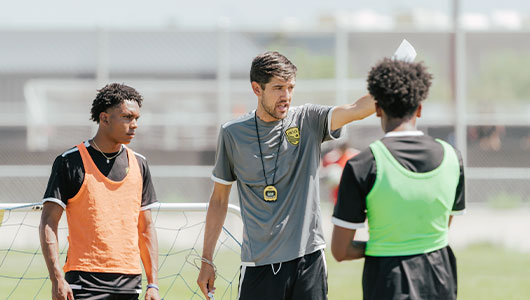Are You Leading
By Example?

Join our email list!
Stay connected with the latest news, resources, and tools from the U.S. Center for SafeSport and enjoy our quarterly e-newsletter, The Gameplan.
Check your email inbox to confirm your U.S. Center for SafeSport Gameplan newsletter subscription.
In your trusted position as a coach, you’re uniquely equipped to support athletes. By promoting strong and healthy relationships among athletes, parents, and coaches, and by spotting emerging problems before they worsen, you can help create an abuse-free sport culture.
Join us in championing athlete safety and well-being.
online training
These trainings created specifically for coaches offer information and tools to help keep kids safe. Get SafeSport® Trained and join our growing community.




Featured Content
Check out Featured Content for videos, articles, interviews, and other abuse education and prevention resources.
Coach faqs
All kinds—and we focus our education, training, and policy work in these areas:
• Sexual
• Physical
• Emotional (includes bullying, harassment, and hazing)
For young athletes in organizations recognized in the U.S. Olympic and Paralympic movement, we provide a safe way to report abuse, and we can help bring abusers to justice.
Sexual Abuse
Child sexual abuse – a form of child abuse that involves sexual misconduct. The employment, use, persuasion, inducement, enticement, or coercion of a child to engage in, or assist another person to engage in, sexually explicit conduct or sexual exploitation of children, including child pornography.
Types of child abuse include:
• Contact behaviors – sexual touching or intercourse.
• Non-contact behaviors – taking pictures of a minor’s breasts, buttocks, or genitals.
• Example: An assistant coach offers to give a minor athlete a massage and then rubs her breasts.
Sexual or gender-related harassment – any unwelcome sexual advance, request for sexual favors, or other unwanted conduct of a sexual nature (whether verbal, non-verbal, graphic, physical, or otherwise) related to gender, sexual orientation, gender identity, or gender expression when employment or participation in sport is determined, at least in part, by if the person accepts or submits to the conduct; or the conduct is severe, persistent, or pervasive enough to limit the opportunity to participate in sport.
Example: A coach offers an athlete a starting position in return for oral sex.
Sexual exploitation – observing, allowing observation of, recording, or photographing private sexual activity or intimate parts without consent of all parties involved, or disseminating images of the same. Also includes engaging in prostitution, trafficking, or intentionally exposing another to a sexually transmitted disease without that person’s knowledge.
Example: A teammate records sexual activity without their partner’s knowledge and then posts the video online.
Intentional exposure of private areas – when an adult intentionally exposes (or makes someone else expose) their breasts, buttocks, groin, or genitals to a minor, or to an adult when there is a power imbalance.
Example: A coach changes in the locker room with the team and purposefully exposes his genitals while talking to the athletes.
Inappropriate physical contact – when an adult who has power over someone intentionally touches, slaps, or otherwise contacts their buttocks or genitals; excessively touches or hugs them; or kisses them.
Example: A volunteer repeatedly hugs an athlete, even after the athlete asks the volunteer to stop.
Physical Abuse
• Intentional contact or non-contact behavior that causes, or reasonably threatens to cause, physical harm to another person.
- • Contact behaviors – punching, slapping, knowingly allowing an injured athlete to compete without proper medical clearance, damaging an athlete’s adaptive equipment.
- • Non-contact behaviors – isolating someone in a confined space, withholding water or nutrition, providing illegal drugs or non-prescribed medications; preventing someone from seeking medical care.
• Does not include professionally accepted coaching methods or contact reasonably accepted as part of the sport.
• Example: An athlete breaks another athlete’s adaptive equipment.
Emotional Abuse
• Behaviors and actions that cause emotional harm to another person including:
- • Verbal acts – screaming at, berating, insulting, body-shaming, or ridiculing someone.
- • Physical acts – punching walls or throwing objects at someone
- • Acts that deny attention or support – isolating someone for extended periods of time or arbitrarily excluding an athlete from practice.
- • Stalking – a course of conduct where one person repeatedly follows, monitors, observes, surveils, threatens, or communicates to or about another person and causes the person fear or emotional distress.
- • Other conduct described as emotional abuse or misconduct under federal or state law.
• Emotional misconduct is different from tough coaching. Tough coaches combine high expectations with positive motivation, respect, and care. Coaches who engage in emotional misconduct use fear, intimidation, and punishment.
• Example: A coach makes fun of an athlete’s mental health disability by calling the athlete “crazy” and asking if they are “off their meds” in front of the team
Coaching can be challenging. You want your athletes to follow your lead and develop the resiliency they need to overcome and achieve, within and beyond their sport. Being able to draw the line between effective discipline and abuse is as necessary for coaches as for any authority figure.
Examples of appropriate discipline include:
- Removing athletes from the starting lineup or game with a clear explanation of why. Coaches need to be able to firmly but compassionately communicate distinctions between behavior-related actions and performance-related actions, and provide clear achievable pathways for improvement for developing young athletes.
- Requiring athletes to arrive early for the next practice to help set up equipment. Teaching an athlete to respect the coach’s and others’ time and contribute effort to a common cause is appropriate discipline.
Examples that cross the line from discipline to abuse include:
- Refusing to allow water breaks. By increasing muscle cramping, and cardiovascular and pulmonary strain, depriving athletes of fuel not only negatively impacts performance, but can have inappropriate, dire, and lasting health impacts.
- Ordering players to re-enter games when they show signs of injury. Your athlete’s physical health and well-being take precedence over winning games.
All coaches, paid or volunteer, should abide by a set of standards that include:
• Creating an environment that does not support any abusive behaviors from coaches, trainers, other staff, parents or other spectators.
• Creating an environment that does not condone any bullying, harassment, or hazing behavior from teammates, other athletes, or spectators.
• Ensuring a clear understanding by all adults working with kids – including coaches, trainers, and administrators – that they are a mandatory reporter if they know or suspect child abuse of any type.
• Establishing, in writing, reporting rules for injured players, including medical clearance prior to an athlete’s return to play.
• Following American Academy of Pediatrics guidelines on proper hydration that include:
- • Children should have appropriate fluids available.
- • Children should consume fluids before, during, and after exercise.
- • Nine- to 12-year-old children should replenish with three to eight ounces of fluid every 20 minutes, and 13- to 17-year-olds may consume 32 to 48 ounces of fluid every hour.
• Policies prohibiting speedy weight gain/loss protocols for participation in youth athletic competitions.
• Policies limiting opportunities for coaches/other staff and volunteers to be alone with youth.
• “Two-deep leadership” to ensure that when youth are disciplined or examined for potential injuries there are two adults present.
When talking to your team about abuse:
• Clearly state team expectations about respectful communication.
• Remind athletes not to engage in abusive behaviors like sexual misconduct, emotional misconduct, bullying, hazing, and harassment.
• Encourage children and family members to speak up when they have questions or concerns, and have a clear policy for families to follow.
• Model the behavior you expect from them.
These conversations aren’t easy or comfortable, but they are important: your athletes view you as a role model. Being frank about these topics lets them know that their safety and well-being is most important to you.
For age-specific recommendations and talking tips, download our Toolkit.
• Do keep open communication with your affected athlete (and, if appropriate, your team) a priority.
• Do remain calm if a child confides abuse. Make sure to document emotional abuse, so if a pattern develops you can report all the incidents.
• Do report the abuse, to appropriate authorities.
• Do tell the affected player you’re glad they shared the information with you and encourage them to come to you whenever a boundary has been crossed.
• Do seek medical attention if necessary.
• Do remind them that their safety remains your first priority.
The U.S. Center for SafeSport has resources available for awareness and abuse-prevention training. We’re here to help your league, club or professional sports organization and volunteers become proficient in national safe-sport practices, and offer free training for parents and youth at varied age-appropriate levels.
about the center
Headquartered in Denver, Colorado, the U.S. Center for SafeSport is an independent, 501(c)(3) nonprofit responsible for responding to end and prevent emotional, physical, and sexual misconduct and abuse in the U.S. Olympic and Paralympic Movement. The Center’s mission is to make athlete well-being the centerpiece of our nation’s sports culture through abuse prevention, education and accountability.

